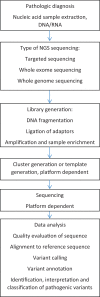A Next-Generation Sequencing Primer-How Does It Work and What Can It Do?
- PMID: 29761157
- PMCID: PMC5944141
- DOI: 10.1177/2374289518766521
A Next-Generation Sequencing Primer-How Does It Work and What Can It Do?
Abstract
Next-generation sequencing refers to a high-throughput technology that determines the nucleic acid sequences and identifies variants in a sample. The technology has been introduced into clinical laboratory testing and produces test results for precision medicine. Since next-generation sequencing is relatively new, graduate students, medical students, pathology residents, and other physicians may benefit from a primer to provide a foundation about basic next-generation sequencing methods and applications, as well as specific examples where it has had diagnostic and prognostic utility. Next-generation sequencing technology grew out of advances in multiple fields to produce a sophisticated laboratory test with tremendous potential. Next-generation sequencing may be used in the clinical setting to look for specific genetic alterations in patients with cancer, diagnose inherited conditions such as cystic fibrosis, and detect and profile microbial organisms. This primer will review DNA sequencing technology, the commercialization of next-generation sequencing, and clinical uses of next-generation sequencing. Specific applications where next-generation sequencing has demonstrated utility in oncology are provided.
Keywords: diagnostic test; microbiology; mutation; oncology; sequencing.
Conflict of interest statement
Declaration of Conflicting Interests: The author(s) declared no potential conflicts of interest with respect to the research, authorship, and/or publication of this article.
Figures
References
-
- Watson JD, Crick FH. Molecular structure of nucleic acids; a structure for deoxyribose nucleic acid. Nature. 1953;171:737–738. - PubMed
-
- Sanger F, Nicklen S, Coulson AR. DNA sequencing with chain-terminating inhibitors. 1977. Biotechnology. 1992;24:104–108. - PubMed
-
- Hunkapiller T, Kaiser RJ, Koop BF, Hood L. Large-scale and automated DNA sequence determination. Science. 1991;254:59–67. - PubMed
-
- Smith LM, Sanders JZ, Kaiser RJ, et al. Fluorescence detection in automated DNA sequence analysis. Nature. 1986;321:674–679. - PubMed
Publication types
Grants and funding
LinkOut - more resources
Full Text Sources
Other Literature Sources


